
Chapter 4
Unlocking the Geologic Record
Evolutionists hold up the fossil record as evidence that evolution has taken place over the billions of years of earth history.
Everybody knows fossils are fickle; bones will sing any song you want to hear.—Shreeve, J., Argument over a woman, Discover 11 (8):58, 1990
Contrary to what most scientists write, the fossil record does not support the Darwinian theory of evolution because it is this theory (there are several) which we use to interpret the fossil record. By doing so, we are guilty of circular reasoning if we then say the fossil record supports this theory.—West, R. (Kansas State Univ.),
Paleontology and Uniformitarianism, Compass 45:216, 1968
What You Will Learn
Evolutionists hold up the fossil record as evidence that evolution has taken place over the billions of years of earth history. Evolution is based on the presupposition that those billions of years have occurred. Using radiometric dating and other dating methods, evolutionists claim that life began on earth about 3.5 billion years ago. Creationists, using the Bible as a starting point, claim that the earth is only about 6,000 years old—and there is abundant evidence that is consistent with this claim. The huge difference is because evolutionists accept uniformitarian (slow and steady) assumptions while creationists believe the worldwide presence of rock layers containing fossils can best be explained by catastrophic processes (rapid and abrupt). Observational science has shown that fossils and rocks can form rapidly. The idea of a young earth is not compatible with evolution.
The sequence of fossils and the rock layers are supposed to strengthen the case for evolution. Two problems with this idea are that many of the fossils occur in the wrong layer sequence and that the rock layers are often bent to an amazing degree—both are evidence for a recent catastrophe. The geologic record should also be riddled with thousands of transitional forms that show a slow and gradual progression, as well as the many dead ends in the evolutionary story. The absence of these transitional forms and the abrupt appearance of many complex life forms is evidence that these groups were created by God and then later buried in the global Flood of Noah’s day. The recent discoveries of dinosaur bones with “fresh” tissue and fossilized amphibian bones with intact bone marrow clearly point to the fact that dinosaurs lived recently. In fact, they shared the earth with humans beginning on Day 6 of creation, just thousands of years ago. That history is accurately recorded in the Bible. Starting with the wrong presuppositions has led people to believe in the wrong history of the earth. Evolution fails to provide a consistent account of earth history, while the biblical creation model puts the evidence into a consistent framework.
What Your Textbook Says about the Geologic Record
| Evolutionary Concept | Glencoe | PH-Campbell | PH-Miller | Holt | Articles |
|---|---|---|---|---|---|
| Soil and sedimentary rocks form slowly over millions of years. | 153 | 299, T299, 392 | 374, 416, 500 | — | 3:24, 4:1, 4:2, 4:3, 4:6, 4:8 |
| The sequence of fossils in the geologic strata is proof of evolution. | 366, 736 | 335–336, 564 | 373, 417 | 283 | 3:24, 3:35, 4:4, 4:5 |
| Species only occur for a short time in earth’s history. | — | 329, T337 | 417, 435 | — | 4:5 |
| Fossil plants have been found with chlorophyll and dinosaur bones with blood components. | — | 335 | — | — | 4:6 |
| Combining the evidence from rocks, fossils, plate tectonics, and chemistry provides a solid basis for evolutionary theory. | 368 | 335 | — | 252, T252, 272– 273 | 3:6, 3:24, 3:29 |
| The earth formed about 4.5 billion years ago. Life first appeared 3.9 billion years ago. | 369–370, 377 | 300, 356 | 410, 423, 447 | 252 | 4:7 |
| “Living fossils” show that evolution can happen at different rates. | 371 | 522, T526 | 416, T416, 567 | — | 4:9 |
| Fossil teeth can help us understand diet and classification. | 371 | 346 | — | 709, 802 | 3:30, 3:36 |
| Grand Canyon formed by slow erosional processes over millions of years. | — | 295 | T375 | — | 4:10, 4:11 |
| Rock layers can be given relative dates; older rocks are lower in the strata. But absolute dates can be found by radiometric dating. | 372, 736 | 299, 336–339, 351 | 20 | 283 | 4:12, 4:15 |
| Radiometric dating provides a reliable way to know the age of rocks. | 372–375, 387 | 338, 340 | T6, 36, 420 | 252– 253, T253, T284, 285 | 4:12, 4:15 |
| Fossils form slowly over millions of years. | 373 | — | 418 | 284–285 | 4:6 |
| Geologic time relates the 4.5 billion year history of the earth. | 374–375, 556–557 | T294, 336– 337, T356, T514 | 129, 422–423, 624–625 | T250– 251, T258, 258– 268, T714 | 4:12, 4:13, 4:14 |
| The geologic column displays the history of life on earth in the sequence of layers. | 375–377, 1084– 1085 | 300, 336 | 382, 419, T772 | — | 3:24, 3:29, 4:13, 4:14 |
| Fossils show a gradual change as you move up the geologic column. | 411 | 295 | 383, 410, 421, T920 | — | 3:24, 3:29, 3:35, 4:13 |
| The Cambrian explosion represents a great diversification in evolutionary history. | 377 | 336, 515, T515 | 430, 746 | 262, T262 | 3:24, 4:16 |
| The fossil record supports the evolution of dinosaurs into birds. | 377–378 | 562, 566, T346 | 432, 807, T807 | 721 | 2:5, 3:24, 3:35, 4:17 |
| Many major extinction events have occurred in earth’s history. Some were caused by meteorite collisions. | 378 | 340, T526, 562 | 431–432, 435, 799, T799 | T262, 263, 392, 723, 724 | 2:5, 4:18, 4:19 |
| The continents were once connected and have drifted apart over hundreds of millions of years. | 378–379 | 322, 339, T339 | T431, 832 | 268, 722 | 4:20 |
Note: Page numbers preceded by “T” indicate items from the teacher notes found in the margins of the Teacher’s Edition.
What We Really Know about the Geologic Record
It is commonly asserted that the fossil record provides the best evidence for evolution happening on the earth. It is important to remember that the geologic evidence is the same for everyone—it is the interpretation that differs. The fossil record is no different. The evidence exists in the present, and the interpretations are about the past. No fossil, rock layer, or dating method can ever prove that evolution did, or did not, happen. The same is true for creation. Recall the distinction made between operational and historical science in Chapter 1. The presuppositions used to interpret the evidence will affect the conclusions. The fossil record must be interpreted; it cannot speak for itself.
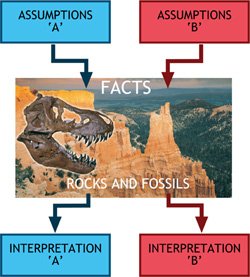
Fossils and rock layers do not speak for themselves—they must be interpreted. The way that you interpret evidence depends on the presuppositions you accept. The Bible offers a different set of presuppositions than naturalistic evolution.
A belief in the story of geologic time is a fundamental idea in all evolutionary contexts. If the vast expanse of time suggested by uniformitarian geology did not occur, evolution could not have occurred.
Most people, including those with training in the sciences, are not aware of the many assumptions that radiometric dating, the geologic column, and fossil interpretation use as foundations. Biologists assume that geologists have correctly identified the age of rocks. The geologists assume that the chemists have correctly identified the half-life of the different isotopes. Chemists assume that the physicists have correctly identified the details of radioactive decay. This chain of assumptions supporting evolution brings down the entire structure if any one of the links is weak.
The idea of geologic time was popularized by Charles Lyell in the mid-1800s. Before then, few people accepted the idea of millions of years of earth history. The development of uniformitarian thinking influenced many people in the scientific community, including Charles Darwin. This idea replaced the idea of catastrophism, a view held by biblical geologists based on the Flood and supernatural creation recorded in Genesis.
Uniformitarianism: the doctrine that present-day processes acting at similar rates as observed today account for the change evident in the geologic record.
The major problem with uniformitarianism is that it is an unverifiable assumption. There is no absolute way to measure past events. Uniformitarianism becomes a presupposition that geologic and biologic sciences are based on. Uniformitarian principles have been applied to most scientific fields, including biology, geology, nuclear physics, and astronomy. Biblical catastrophism also falls under the category of a presupposition, but it is based on God’s eyewitness accounts of the Flood and creation recorded in Genesis.
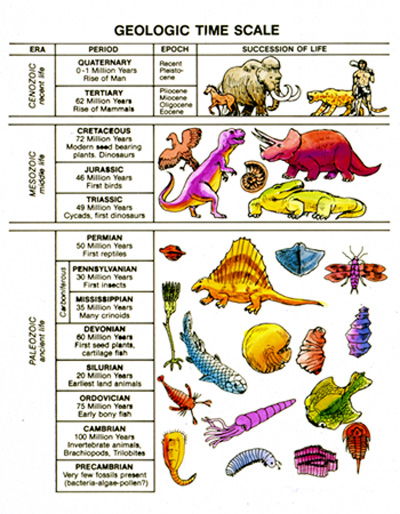
Illustrations, like this one, are actually made from combining pieces of the geologic column from all over the world. Geologists make many assumptions when trying to explain all of the fossils and rock layers.
Catastrophism: the doctrine that changes in the geologic record are a result of physical processes operating at rates that are dramatically higher than are observed today.
The illustrations of geologic time and the geologic column are actually composites compiled from many different sources. The fossil and geologic evidences are pieced together from all over the globe. The presence of unconformities (places where there are gaps in the sequence) is explained away, and the fact that many “ancestral” species occur higher in the strata than their descendants is ignored in these simplified illustrations. The reliability of the geologic and fossil record is summarized candidly in the quote below.
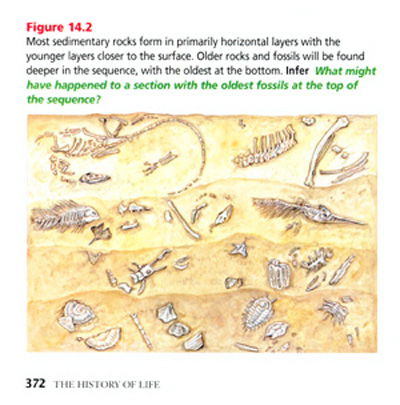
(Glencoe 372) This illustration offers a false picture of what the geologic record actually looks like. The layering of fossils is not as neat and tidy as the illustration suggests. The many gaps and out-of-sequence layers suggest that the layers and fossils did not form in the way evolution suggests. Instead of challenging the underlying presupposition of gradual formation of the rock layers, the interpretation within the uniformitarian framework is adjusted. The assumption of the age of the fossils is not questioned in evolutionary thinking.
Structure, metamorphism, sedimentary reworking and other complications have to be considered. Radiometric dating would not have been feasible if the geologic column had not been erected first. The axiom that no process can measure itself means that there is no absolute time, but this relic of the traditional mechanics persists in the common distinction between “relative” and “absolute” age.
—D’Rourke, J. E., Pragmatism vs. materialism in stratigraphy, American Journal of Science 276:54, 1976
Relative ages are assigned to rocks based on the idea that rock layers that are lower in the strata were deposited before rock layers that are higher. Creationists do not necessarily disagree with this concept, but it can only be applied to layers that are found in one location and are continuous. Determining the relative age of a rock layer is based on the assumption that you know the ages of the rocks surrounding it. Uniformitarian geologists use so-called absolute dating methods to determine the ages of the surrounding rocks.
Certain types of rocks, especially those that form from magma (igneous), contain radioactive isotopes of different elements. It is possible to measure the ratio of the different radioactive isotopes in a rock, but the ratios are not dates or ages. The dates must be inferred based on assumptions about the ratios. Some of the common isotope pairs used are K-Ar, Rb-Sr, Pb-Pb, and U-Pb. Carbon-14 dating is another common technique, but it can only be used on things that were once alive. The method of calculating radiometric dates is like using an hourglass. You can use the hourglass to tell time if you know several things: the amount of sand in the top of the hourglass when it started flowing, the rate that the sand flows through the hole in the middle, and that the quantity of sand in each chamber has not been tampered with. If any of these three conditions are not accurately known, the hourglass will give an inaccurate measure of time.
Radiometric dating is based on the fact that radioactive isotopes decay to form isotopes of different elements. The starting isotope is called the parent and the ending is called the daughter. The time it takes for one half of the parent atoms to decay to the daughter atoms is called the half-life. If certain things are known, it is possible to calculate the amount of time since the parent isotope began to decay. For example, if you began with 1 gram of Carbon- 14, after 5,730 years you would be left with 0.50 g and only 0.25 g after 11,460 years. The reason this age may not be a true age—even though it is commonly called an absolute age—is that it is based on several crucial assumptions. Most radiometric dating techniques must make three assumptions:
- The rate of radioactive decay is known and has been constant since the rock formed.
- There has been no loss or gain of the parent or daughter isotopes from the rock.
- The amounts of parent and daughter isotopes present when the rock formed are known.
The major problem with the first assumption is that there is no way to prove that the decay rate was not different at some point in the past. The “fact” that decay rates have always been constant is actually an inference based on a uniformitarian assumption. It is true that radioisotope decay rates are not largely affected by external conditions like change in temperature and pressure. Recent research by a creation science group known as RATE (Radioisotopes and the Age of The Earth) has produced evidence of an accelerated rate of decay at some point in the past. Creation scientists suggest that there are two possible times that God supernaturally intervened on a global scale—during Creation Week and the Flood. It is not unreasonable to assume that God used the energy of accelerated radioactive decay to initiate and drive the major geologic changes in the earth that accompanied the Flood.
The assumption that there has been no loss or gain of the isotopes in the rock (assumption 2) does not take into account the impact of weathering by water and the diffusion of gases. It is impossible to know to what degree the parent and daughter products have been added to or removed from the rocks over the alleged millions or billions of years.
The final assumption (assumption 3) does not take into account the fact that isotopes can be inherited from surrounding rock as the magma passes through the mantle and crust of the earth. Uniformitarian geologists do make efforts to eliminate errors, but the fact that rocks of known recent age give dates of millions of years supports the claim that radiometric dating cannot provide accurate “absolute” dates. Also, samples taken a few feet apart can give ages that differ by hundreds of millions of years.

Fossils do not come with an age stamped on them. The dates must be interpreted from the evidence. Creationists interpret the evidence in light of the Bible and suggest that most fossils are a result of Noah’s Flood. Evolution denies the authority of the Bible and uses uniformitarian thinking to interpret the evidence.
Some people do not realize that fossils themselves are usually not directly dated. Instead, layers that contain datable igneous rocks above or below a fossil are used to estimate the age of the fossil. The age of the fossil can be estimated within the range of the layers above and below it. In some cases the ages are correlated to other rock layers of supposedly known age or by using index fossils. These methods assume that the distribution of index fossils and the correlation of strata are well understood on a global scale.
Evolutionists believe that a progression through the history of life can beseen as you move up the geologic layers. Since the rock layers are assumed to have been laid down over billions of years, the rocks at the bottom should have the simplest forms of life, and those at the top should have more advanced forms of life. Darwin realized that if his theory were true a large number of transitional fossils would be found in the fossil record. The lack of these transitional fossils was one of the points on which Darwin said his theory would be falsified.
The lack of transitional fossils is most obvious in the rock layers from what is known as the Cambrian Period. The majority of basic multicellular body plans appear very abruptly in what is called the “Cambrian explosion.” In this layer of rocks, we see an amazing array of living things that are supposed to have evolved from previous organisms. The problem is that the transitional fossils are nowhere to be found in the lower rock layers. Instead of questioning evolutionary ideas in light of this evidence, evolutionists assert that the organisms were just not fossilized or that we haven’t found them yet. Creationists interpret this abrupt appearance of life in the rock record as support for the catastrophic Flood. Other theories, like saltation and punctuated equilibrium, were proposed to describe the “jerky” nature of the fossil record. Whatever the explanation, it is clear that the fossil record is not the tightly bound case for molecules- to-man evolution that evolutionists make it out to be.
The geologic layers, plate tectonics, radiometric dating, and the fossil record can all be explained within the framework provided by the Bible. Starting from the Bible—instead of naturalism—the layers of rock all over the world with billions of dead things in them are the result of the worldwide Flood described in Genesis. Although much work remains to determine the details of how the plates moved and which strata were deposited during which stages of the Flood, the overall model offers a great deal of explanatory power. Starting with the Bible as truth will lead to a much better explanation than starting with the faulty assumptions of man.
Reference Articles
4:1 Paleosols: digging deeper buries “challenge” to Flood geology, Walker, TJ 17(3):28–34, 2003
Paleosols are a favorite objection used against the global Flood and the 6,000-year biblical age of the earth. Uniformitarians believe that paleosols (ancient soil horizons) are common throughout the geologic record. Soils are believed to take hundreds to thousands of years or more to form, and they supposedly represent periods of earth history when the area was not covered with water. Uniformitarians argue that paleosols could not have formed in the midst of a global flood. However, when examples of alleged paleosols are examined, they do not stand up to scrutiny. The loose horizons do not have the characteristics of soils, and the interpretation of a paleosol is inconsistent with the sequence of geological events needed to form such layers. Instead, the field evidence fits the biblical framework much better than the uniformitarian one. The soils examined do not form by surface weathering over a long time but by “weathering” within the rock layers during and after the global Flood.
4:2 Rapid rock, Walker, Creation 24(2):38–39, 2002
Many people believe that it takes millions of years to form sedimentary rocks from soil. The fact is it only takes the right solution of minerals and a very short amount of time. A product developed in Australia injects the mineral solution into soils, and the particles are cemented together in place in a matter of days. Applying repeated treatments of the minerals increases the strength of the rock formed. During a global flood, the amount of dissolved minerals would be very high, and the formation of the sandstones could have happened very rapidly.
4:3 Can Flood geology explain thick chalk beds? Snelling, https://answersingenesis.org/geology/sedimentation/can-flood-geology-explain-thick-chalk-beds/
Chalk deposits are the calcite remaining from the shells of microorganisms: foraminifera and coccolithophores. Evolutionists argue that the Flood model does not allow for the thick layers of chalk found all over the world. Uniformitarian geologists assume that the chalk layers form as the shells of these dead microorganisms fall to the ocean floor and slowly build up. Calculations done by Dr. Ariel Roth suggest that the rate of formation of the chalk layers is not a problem in the time span before the Flood. John Woodmorappe took the 17.5 million cubic kilometers of limestone and chalk that exist in the same layers as chalk beds and calculated that only 4.1% of the earth’s surface would need to be covered with the microorganisms to form the rocks.
The problem is not only how much chalk could have been formed but when it was formed. The chalk deposits sit in a layer that is thought to have been formed during the Flood. The conditions during the Flood (warm water, wind, upwelling, nutrient flow from the land, and decaying animals) would have been ideal for the microorganisms and could have caused a bloom in the populations. Under these conditions, the organisms needed for chalk formation could have grown quite rapidly. The purity of the chalk beds is another testament to the rapid nature with which they formed, a fact that evolutionists have a hard time explaining away. The biblical Flood offers a reasonable explanation for the formation of the thick, pure chalk layers seen around the world.
4:4 Fossils—do they get more complex? https://answersingenesis.org/fossils/fossil-record/fossils-do-they-get-more-complex/
Evolutionary theory would predict that organisms lower in the geologic strata would be less complex than those in higher layers. When evolutionists looked at ammonite shells and descendant-ancestor pairs of vertebrates, no trend in increasing complexity was found.
4:5 The fossils say what? Ham, https://answersingenesis.org/fossils/the-fossils-say-what/
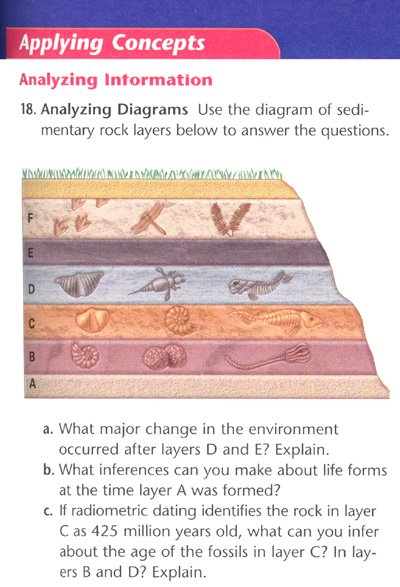
(PH-Campbell 351) The fact that the illustration shows increasing complexity in higher strata does not mean that evolution has occurred. Evolution predicts a gradual series of complexity within a group. The gradual changes of evolutionary history (i.e., simple reptile to complex reptile) are not found in the fossil record. In many cases, the evolutionary “ancestor” is found in higher strata.
Most evolutionists have abandoned the idea that humans are the pinnacle of evolution; bacteria have been evolving just as long as humans have. No organism can be considered more evolved than another—evolution is not an upward or goal-directed process. Using this concept, man is no more important than cows or mosquitoes. This runs contrary to the Bible’s teaching that man was made in the image of God. Evolution offers man “freedom” from right and wrong, while the Creator God demands accountability from his creation.
4:6 Dinosaur soft parts, Morris, www.icr.org/article/2032
The discovery of a T. rex bone that contained soft tissues has forced evolutionists to reconsider their ideas about fossilization. The bone, which is allegedly 70 million years old, was found in porous sandstone that should have allowed the bone to fill with mineral deposits. The fact that the bone was still “fresh” does not prove it is young, but it does challenge the validity of the 70 million year old date. Any biological material should have broken down in that time. It even stretches the limits of the creationist date of fewer than 5,000 years.
Secular scientists deny the possibility that the age is wrong and are trying to explain the amazing preservation through natural processes.

The presence of soft tissue structures found in dinosaur fossils makes it clear that they are not 70 million years old.
4:7 Focus: Ancient organisms stay the same, https://creation.com/focus-213
A while ago, evolutionists would not have expected to find any fossils in rocks that they thought were, say, three billion years old—life supposedly hadn’t evolved yet. However, fossils of bacteria kept turning up in progressively “older” rocks (no surprise to creationists), which allowed less and less time for the first life to evolve in the hypothetical, oxygen-free “early atmosphere.” Now an Austrian/ Swiss team of scientists has looked at rock from Western Australia’s Pilbara region, supposedly around 3.5 billion years old, and found fossilized cyanobacteria. These appear to be indistinguishable from the same (oxygen-producing) creatures making the mat structures called stromatolites in the shallows of Shark Bay, some 500 kilometers away on the coast.
4:8 Focus: Rocks forming in months, https://creation.com/focus-172
Stones measuring up to a foot across are forming in a Norfolk (UK) marsh in a process which is happening in a few months or years. Small (and not so small) black lumps of rock are forming, as bacteria thriving on rotting vegetation produce “an iron-rich form of limestone, which acts as a mineral cement, binding the sand and mud together.” Geologists have dug up similar stones before, which “often contain beautifully formed fossils.” These fossils show a lot of detail of the soft flesh, “as it had no time to rot before the rock formed around it.” Geology Professor Max Coleman, who works for BP, is keen to study the marsh. The rock is “forming faster than anyone had ever believed possible, with one stone creating itself in just six months” (Eastern Daily Press, UK, October 5, 1994). Creationists have long pointed out that hardening of sediments into rock is mainly a matter of the right cementing substances being present and that it doesn’t require millions of years.
4:9 “Living fossils” enigma, Catchpoole, Creation 22(2):56, 2000

The presence of “living fossils” like this coelacanth casts doubt on the value of evolution as a predictive model—organisms can change rapidly or stay the same for hundreds of millions of years. Other examples of living fossils include wasps, dragonflies, stromatolites, Ginkgo, clams, and the Wollemi pine.
Thousands of examples of creatures living today are virtually identical to their ancestors which supposedly lived hundreds of millions of years ago. These include many insects, the Wollemi pine, Ginkgo trees, crocodiles, coelacanths, and many marine invertebrates. How can evolution explain that some creatures have remained unchanged for such long periods of time while others have changed relatively rapidly? There is no real consistent answer. Some say it is due to long generation times, but that doesn’t work for cockroaches and bacteria that reproduce in days or minutes. Some say that it is just chance and luck, but that is intellectually unsatisfying to others. Others say it is because of the lack of habitat change, but that only works in a few examples. Ultimately, evolutionists can provide no clear explanation of why these “living fossils” are still with us today. Creationists, however, understand that the ancestors of these organisms were created only 6,000 years ago. This timeframe makes the explanation rather simple—they have survived for a few thousand years relatively unchanged, not millions.
4:10 Grand Canyon strata show geologic time is imaginary, Walker, Creation 25(1):41, 2002

Uniformitarian thinking says that most canyons form from a little water over a long period of time. Catastrophism explains canyon formation from a lot of water over a short time. Canyons near Mount St. Helens and the scablands of eastern Washington provide evidence of canyon formation in a matter of days.
Visitors to Grand Canyon hear the usual geological interpretation involving millions of years. Guests are told that the horizontal formation at the bottom, the Tapeats Sandstone, was deposited 550 million years ago, and the Kaibab Limestone that forms the rim is 250 million years old. It is difficult to imagine the immense time involved in this interpretation. Interestingly, the Grand Canyon strata extend over 250 miles into the eastern part of Arizona. There, they are at least one mile lower in elevation. Supposedly, the uplift of the Grand Canyon area occurred about 70 million years ago—hundreds of millions of years after the sediments were deposited.
One would expect that hundreds of millions of years would have been plenty of time for the sediment to cement into hard rock. Yet, the evidence indicates that the sediments were soft and unconsolidated when they bent. Instead of fracturing like the basement rock did, the entire layer thinned as it bent. The sand grains show no evidence that the material was brittle and rock-hard, because none of the grains are elongated. Neither has the mineral cementing the grains been broken and recrystallized. Instead, the evidence points to the whole 4,000 foot thickness of strata being still flexible when it was uplifted. In other words, the millions of years of geologic time are imaginary. This flexible deformation of the Grand Canyon strata dramatically demonstrates the reality of the catastrophic global Flood of Noah’s day.
4:11 A canyon in six days! Morris, www.answersingenesis.org/go/walla-canyon
Most people are taught that Grand Canyon formed as the Colorado River eroded the landscape over tens of millions of years. The fact that the same results could be accomplished with a lot of water over a short time is generally not mentioned. Observations of canyon formation in modern times suggest that Grand Canyon may have formed much as did a small canyon near Walla Walla, Washington—a lot of water over a short time. During an unusually wet period, a small irrigation ditch was used to divert some excess water. As the water passed through the ditch, it became a gully, then a gulch, then a canyon, 1,500 feet long and 120 feet deep. This all happened in six days, not millions of years. The similar formation of the Toutle River canyon near Mount St. Helens offers another example that is analogous to what would have happened as the floodwaters receded in the days of Noah.
4:12 National Geographic plays the dating game, Woodmorappe, https://answersingenesis.org/geology/radiometric-dating/national-geographic-plays-the-dating-game/
National Geographic magazine is known for its amazing photography and cultural coverage, as well as its evolutionary support. In an article on radiometric dating, the many assumptions that must be made to arrive at dates of millions of years were not discussed. This failure to discuss the underlying assumptions leaves the layperson thinking that determining the age of rocks is a fool-proof science. The article uses the Hubble constant to establish an old age of the universe without mentioning the many problems with big bang cosmology. The oldest rocks on earth are said to be 4.03 billion years even though rocks dating 10 billion years old have been recorded. The rate of radioactive decay is assumed to be constant throughout history, even though this cannot be proven. Several evidences in the RATE project seem to support the idea that the rate of radioactive decay has not always been constant.
All dating methods assume that the rock is a closed system where none of the parent or daughter isotopes can enter or leave. The assumption that dates are accurate if they are consistent across methods, known as isochrons, is based on assumptions, and the majority of dates are not consistent for a given rock. Geologists generally do not test more than a few methods on a limited number of samples, and when they return “impossible” dates, they are rejected completely. When many dates are returned for a sample, the “proper” date is selected to fit the expected age. The presence of wood in a lava flow that was dated millions of years younger than the rock (and lower strata dating much younger than higher strata) call the assumptions into question. Samples from lava flows of known age regularly return ages of millions of years instead of the actual age. The many assumptions involved in radiometric dating, coupled with the unreliable nature of the dates, calls into question the results of radiometric dating.
4:13 How well do paleontologists know fossil distributions? Oard, https://answersingenesis.org/fossils/fossil-record/how-well-do-paleontologists-know-fossil-distributions/
Scientists often use the presence of index fossils to estimate how old a given layer of rock is. The problem is that many virtually identical specimens are found in different geologic layers and separated from one another. Based on the standard uniformitarian assumptions, these specimens are given different names. This overstates the actual number of species found in the fossil record and confuses their distribution. There are often large gaps of missing time between the two specimens. Evolutionists have trouble explaining why the species is not found in the layers between the two fossil specimens, but creationists have no difficulty. The Flood model explains the wide distribution and the different levels as the organisms were buried in different places during the same Flood event. The actual three-dimensional distributions of fossil species is not known by paleontologists, but it is used to prove that evolution and evolutionary time are true.
4:14 The geologic column: does it exist? Woodmorappe, www.trueorigin.org/geocolumn.php
The geologic column exists in only one place on earth— in the textbooks. The geologic column consists of the layers (strata) of rocks from the crystalline basement rocks to the most recently deposited soils. The actual geologic column, representing the maximum thickness of all of the layers, would be over 100 miles thick, which occurs nowhere on earth. Now, parts of the 10 major layers are present on top of one another (up to 16 miles thick), but the column, as a whole, is a composite of local layers that are assumed to fit one atop the other. The index fossils that are said to be evidence of the age of a given strata are rarely found directly above older index fossils in the same area. To relate the index fossils, the layers from one area must be artificially placed above those from another area. Roughly 1% of the earth’s surface is covered by the 10 layers in succession, but these areas have not all been classified accurately based on the index fossils and other signs of life found in them.
It is not necessary for Flood geology to explain the strata of the geologic ages covering the whole earth because that covering does not exist. Creationists are currently working on models to explain the local layers by Flood-related processes.
4:15 The way it really is: little-known facts about radiometric dating, Walker, Creation 24(4):20–23, 2002
Many people believe science can directly measure the age of a rock, and the numbers that are given make the dating sound very accurate. We can measure many things about a rock, but its age is not one of those. The age must be inferred from a ratio of radioactive isotopes and based on assumptions. Even when a date is determined for a rock, it is only accepted if it fits what the evolutionist expected. The dates are accepted if they fit between the assumed ages of the rocks above and below the layer the rock came from. The rocks above and below may have been given ages by other geologists based on the types of index fossils found in them.
If field study suggests that the upper rocks were 30 million years old and the lower rocks were 200 million years old, a radiometric date anywhere in that range would be acceptable. If a sample is sent to a lab to be dated and the age comes back at 300 million years old, the other dates and the method of analyzing the sample are not questioned— the date is explained away by contamination or some other explanation. If the date comes back too young, the factors of groundwater and weathering can explain away the data. There is no reason to question the methods of interpretation—it is already “known” how old the rock should be. The methods are not bad; you just have to know how to interpret them to fit the date you expect. Creationists reject the notion of millions of years based on the Bible, but the method of radiometric dating can still be useful for determining relative ages in some instances. The many bad dates that result make you wonder how evolutionists trust a system that gives such poor results. The many assumptions that radiometric dates are based on make the process very unreliable and open to interpretation.
4:16 What grows on evolution’s tree? Morris, www.icr.org/article/577
Evolutionists use the concept of the tree of life to show how all life on earth originated with a single common ancestor. The evidence for the branching tree cannot be found in the fossil record where there are many gaps and reversals. Textbooks present this tree as fact and the evolutionary indoctrination continues. The falsity of the tree is most evident in the “Cambrian explosion.” In these rock layers the majority of body plans (phyla) appear completely formed without evidence of their ancestry in the layers below. There have been no new phyla since the Cambrian Period when they all appear suddenly. The fossil record stands as a firm testimony to the creation of life, not its evolution by natural processes.

The fact that Archaeopteryx has reptilian characteristics does not mean that it is not a bird. Several living birds, like the hoatzin, have claws on their wings like Archaeopteryx. Experts generally agree that Archaeopteryx is a bird, not a transitional form.
4:17 Claws on wings, https://answersingenesis.org/birds/claws-on-wings/
Many people have tried to say that the proof that reptiles evolved into birds is to be found in a fossil bird called Archaeopteryx, which shows claws on its fossilized feathered wings. But all the living birds with claws on their wings are obviously birds! Archaeopteryx and the living “clawed” birds tell us only that some kinds of birds have wing claws and some don’t. Such claws are not something new in birds, and they certainly don’t show that birds with them are any more reptile-like than birds without such claws.
4:18 The Permian extinction: National Geographic comes close to the truth, Silvestru, TJ 15(1):6–8, 2001
Evolutionists believe that a mass extinction, wiping out 90% of the planet’s species, occurred about 250 million years ago. The presence of 9 major extinctions has led to much speculation about the cause. Some suggested causes of the Permian extinction are major asteroid impacts, increased volcanism, and depleted oxygen in the oceans. The asteroid impact supposedly caused major dust clouds that led to the collapse of food chains and eventually acute global warming, which wiped out most species. The theory using ocean oxygen levels is unsupported by real evidence. There is a large amount of volcanic activity in Siberia at this point in the strata, and some argue the asteroid evidence is better explained by these volcanoes. The same sort of sunblocking chain reaction would result from massive volcanic activity.
Creationists explain the apparent mass extinctions as distinct events or zones within the year of the Flood. The idea of asteroid impacts as a trigger for the Catastrophic Plate Tectonics Model developed by Dr. John Baumgardner is an interesting idea. The idea of a lot of small catastrophes over millions of years can all be encapsulated into the 371- day Flood. The evidence for a global flood is misinterpreted by the uniformitarian geologists.
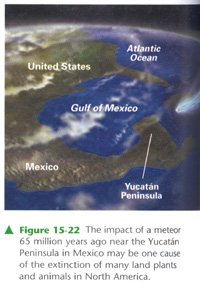
(PH-Campbell 340) Many people believe that one or more of the major extinction events in evolutionary history occurred as a result of a meteorite hitting the earth. In the picture here, the meteorite that is alleged to have hit in the Yucatan area is depicted. The creation model uses the Genesis Flood to explain the sudden disappearance of the majority of life on earth and the presence of billions of fossils buried in rock layers laid down by water.
4:19 The extinction of the dinosaurs, Oard, https://answersingenesis.org/dinosaurs/extinction/the-extinction-of-the-dinosaurs/
The disappearance of dinosaurs from the earth in a relatively short time has been a major puzzle for evolutionists. Their wide distribution and adaptation to many climates deepens the mystery. Studying extinctions is difficult because the classification and distribution of species is not well described. Up to nine major extinction events are supposedly preserved in the fossil record, the one at the end of the Cretaceous being the most extensive.
Different theories on extinction range from one extreme to the other, including temperature, nutrition, and food supply. Lately, the meteorite extinction theory seems to be the most prevalent. A massive meteorite struck the earth, ejecting debris into the air that cooled the atmosphere. A layer of iridium concentration around the globe, the presence of shocked quartz, and many other types of evidence are supposed support for the theory. The cooling from the debris is alleged to have caused the extinction of the dinosaurs.
A competing theory suggests that the data supports a period of massive volcanic activity. Many types of evidence, including the iridium and quartz evidence, are given as support for the theory. The increased volcanic activity would have caused the same cooling effect, as well as releasing toxic gases and killing the dinosaurs. Opponents of each theory have valid arguments to refute one another.
Creationists hold that the destruction of most of the dinosaurs, as well as most other life forms, is accounted for by Noah’s Flood. Those dinosaurs that survived the Flood in the Ark have died off since then for various reasons. While there are still many unknowns in the fossil distribution, the presence of massive fossil graveyards, trackways that represent fleeing behavior, quickly deposited layers without channels forming, and other factors clearly point to a flood of global proportions. There are certain aspects of Flood geology that are not entirely understood, but the models are constantly being refined to accommodate these observations. The likelihood of volcanoes and/or meteorite collisions during the Flood explains the evidence for the two most popular secular theories adequately. In total, the Genesis Flood provides a satisfactory explanation for the extinction of a majority of the dinosaurs.
4:20 What about continental drift? Batten, Ham, Sarfati, Wieland, www.answersingenesis.org/go/continental-drift
The idea of plate tectonics was not widely accepted until the 1970s. The “fit” of the continents, fossil evidence, and seafloor spreading are major evidences for the movement of the earth’s tectonic plates. The fact that the seafloor shows evidence of reversals in the magnetic field leads to a conclusion that the reversals happened rapidly over a short time. This is contrary to the idea of the plates spreading slowly over millions of years.
Creation scientist Dr. John Baumgardner developed computer models while working at Los Alamos National Laboratories. His model, called Catastrophic Plate Tectonics, shows how a rapid spreading of the continents makes more sense. It wasn’t continental drift but continental sprint that separated the continents. The heat generated would produce massive amounts of steam that could have been one of the sources of rain in the Flood.
Questions to Consider
- How are polystrate fossils, like upright trees, explained if each of the layers surrounding the fossil takes long periods of time to form? Wouldn’t the wood rot away before it was covered?
- Do radiometric dating techniques always show that rocks lower in the geologic layers are older than rocks that are higher?
- If radiometric dating on rocks known to be only a few years old yields dates of hundreds of millions of years, why should we trust that the techniques can be used to accurately date rocks of unknown ages?
- Don’t large fossil graveyards suggest a major catastrophe? Could a massive flood explain these deposits?
- How could large fossil graveyards be explained without a massive catastrophe?
- How soon after death would a large dinosaur (or a group of large dinosaurs) need to be buried by sediment to prevent scavengers from scattering its bones? It would seem this would need to be a catastrophic event to bury this large animal in sediment.
- How do artists decide what an extinct organism should look like? Would a camel skeleton indicate whether it had one or more humps?
- If you gave the same hominid bones to four different artists, would they draw the same picture of the creature? Why should we trust, or even use, artists’ representations in science? (See Behind the Scenes, National Geographic, March 2000, p. 140 for an article on Homo habilis fossil drawings.)
- If the Cambrian explosion happened because of empty ecological niches, why didn’t similar events occur after later extinction episodes?
- In radiometric dating techniques, how do we know how much parent material the sample started with? How do we know none of the parent or daughter isotope was added or removed? How do we know the decay rate is constant?
- When items are carbon-14 dated, how do we know how much carbon-14 was initially present in the sample? Could the ratio of carbon-12 to carbon-14 have been different at different times in earth’s history? How can scientists accurately adjust their calculations if the isotope ratios were never observed and recorded?
Tools for Digging Deeper
(see a complete list in the Introduction)
The New Answers Book by Ham, et al.
Creation: Facts of Life by Gary Parker
Evolution: The Fossils Still Say No! by Duane Gish
The Fossil Book by Gary Parker
The Geology Book by John Morris
Evolution Exposed: Biology
This book helps teens discern the chronic bias towards belief in evolution that permeates today’s three most popular high school biology textbooks.
Read Online Buy BookRecommended Resources

Answers in Genesis is an apologetics ministry, dedicated to helping Christians defend their faith and proclaim the good news of Jesus Christ.
- Customer Service 800.778.3390
- Available Monday–Friday | 9 AM–5 PM ET
- © 2026 Answers in Genesis


